
These are great discussion or quick write prompts.
- Subject:
- English Language Arts
- Material Type:
- Activity/Lab
- Author:
- Janis Meredith
- Date Added:
- 10/24/2022

These are great discussion or quick write prompts.
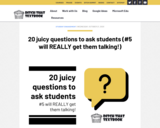
"A great question is a springboard into a fascinating discussion. Phrase it the right way and students will start thinking. Then they'll start talking. Then you won't be able to get them to stop!
Great questions can make the difference between a good learning activity and a great one."
This includes 20 questions as well as many ideas to make your own questions including - student interests, audio, images, video, would you rather, summaries, lists, fantasies, mysteries.

This is a collection of ideas for classroom discussion to get EVERYONE involved!
Strategies include:
Quiz, quiz, Trade
Opinion Poll
Stepladder
Gogomo
World Cafe
Brainwriting
Thinking Hats
Tug of War
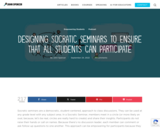
Socratic seminars are a democratic, student-centered, approach to class discussions. They can be used at any grade level with any subject area. In a Socratic Seminar, members meet in a circle and share their insights. Participants do not raise their hands or call on names. Because there’s no discussion leader, each member can comment or ask follow-up questions to one another. This approach can be empowering for participants because they own the conversation. Unlike a typical class discussion, the conversation moves fluidly back and forth rather than having to go through the teacher.
This article outlines several approaches to conducting a Socratic Seminar:
- The Giant Circle Approach
- The “Fish Bowl” Approach
- The Round Table Approach
- The Scattered Approach
- Multiple Seminars
- Online/Offline Seminars
The author also provides a sample of how to run a Socratic Seminar and tips for ensuring that all students can participate.

An overviewe of the Collaborative Learning Cycle Presentation.
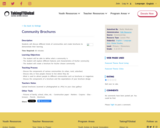
Students will discuss different kinds of communities and create brochures to demonstrate their learning.

PowerPoint and Google Slides are available as templates to create your dialogue.
This is a great way to discuss difficult and troubling topics in a safe and supportive manner - instead of avoiding them.
Run the template via Pear Deck to make it interactive.

This site will give you a quick run down of how to use Figjam and then it provides 20 great ideas for using Figjam in the classroom - including the templates to get started!
There is even a video to keep it very easy!
Tutorials are linked at the bottom of the site as well.
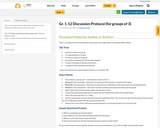
This is a low organization, high impact strategy to use for reflection and discussion in your classroom.

Students examine their schoolyard for litter and graph its spread. Using TIGed Collaborations, your students can share their results with other students around the world and discuss what the causes might be for any differences.

"Use Kialo to help students get to the core of the issues they’re discussing To put their knowledge into action.
To sharpen their critical reasoning skills
To demonstrate their understanding
To engage constructively with each other
Take your classroom discussions online, break down complex subjects for students, and shake it up with new types of assignments."
This education version is free for teachers to use!

Parent and Teacher Guides to Talking About Cannabis Marijuana Government of Saskatchewan.

Nous fournissons des ressources pédagogiques gratuites basées sur le programme et des outils en ligne pour vous aider à enseigner les droits de l’homme à vos élèves.
En vous inscrivant à notre tableau de bord des enseignants, vous pouvez accéder aux plans d’enseignement et aux outils d’évaluation. Nous proposons également des webinaires qui fournissent des informations utiles sur la façon d’utiliser nos supports en classe.
Dans six unités, les élèves explorent des sujets et des problèmes liés au sectarisme, à la discrimination et aux droits de l’homme. Le programme les aide à apprendre de l’histoire et à devenir plus conscients de leurs propres préjugés et perspectives.

Students explore the applications of quantum dots by researching a journal article and answering framing questions used in a classwide discussion. This "Harkness-method" discussion helps students become critical readers of scientific literature.
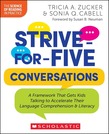
From Melissa & Lori Love Literacy
"Our guests today, authors Tricia Zucker and Sonia Cabell, discuss the concept of Strive-For-Five Conversations, which emphasizes the importance of multi-turn conversations between teachers and students. They explain that the goal is to stretch conversations beyond the typical question-response format and aim for at least five turns. The conversation explores the importance of building relationships with parents and the impact of conversations on brain development. They also provide practical tips for implementing Strive for Five in the classroom and engaging parents in the process."
Learn how to have meaningful conversations and develop relationships & oral language skills!

This site houses a collection of ready to go resources including:
*tools
*templates
*visual
*recall
*no technology
Find slides at ditch.link/cabinetlinks